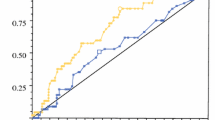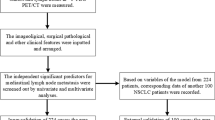Abstract
Purpose
To evaluate the relationship between SUVmax of primary lung cancers on FDG-PET and lymph node metastasis.
Method and materials
The subjects were a total of consecutive 66 patients with lung cancer who were examined by FDG-PET and subsequently underwent surgery between October 2004 and January 2008. There were 41 males and 25 females, ranging in age from 45 to 83 years with an average of 68 years. The pathological subtypes of the lung cancers consisted of 49 adenocarcinomas, 11 squamous cell carcinomas, 2 adenosquamous carcinoma, 1 large cell carcinoma, 1 small cell carcinoma, 1 pleomorphic carcinoma and 1 mucoepidermoid carcinoma. We statistically compared (1) the mean SUVmax of lung cancer between the groups with and without lymph node metastasis (2) the frequency of lymph node metastasis between higher and lower SUVmax of lung cancer groups that were classified by using the median SUVmax of lung cancer, and (3) evaluated the relationship between the SUVmax of lung cancer and frequency of lymph node metastases, and (4) correlations between the SUVmax of lung cancer and number of the metastatic lymph nodes and pathological n stages.
Results
The difference in the average of the SUVmax of lung cancer between the cases with and without lymph node metastases was statistically significant (p = 0.00513). Lymph node metastasis was more frequently seen in the higher SUVmax of lung cancer group (17/33, 52%) than in the lower SUVmax of lung cancer group (7/33, 21%) with a statistically significant difference. There was no lymph node metastasis in lung cancers with an SUVmax of lung cancer less than 2.5, and lung cancers with an SUVmax of lung cancer more than 12 had a 70% frequency of lymph node metastasis. There were moderate correlations between SUVmax of lung cancer, and the number of the metastatic lymph nodes (γ = 0.404, p = 0.001) and pathological n stage (γ = 0.411, p = 0.001).
Conclusions
The likelihood of lymph node metastasis increases with an increase of the SUV of a primary lung cancer.





Similar content being viewed by others
References
Onishi H, Araki T, Shirato H, Nagata Y, Hiraoka M, Gomi K, et al. Stereotactic hypofractionated high-dose irradiation for stage I nonsmall cell lung carcinoma: clinical outcomes in 245 subjects in a Japanese multiinstitutional study. Cancer 2004;101:1623–31.
Onishi H, Shirato H, Nagata Y, Hiraoka M, Fujino M, Gomi K, et al. Hypofractionated stereotactic radiotherapy (HypoFXSRT) for stage I non-small cell lung cancer: updated results of 257 patients in a Japanese multi-institutional study. J Thorac Oncol. 2007;7:94–100.
Steinert HC, Hauser M, Allemann F, Engel H, Berthold T, von Schulthess GK, et al. Non-small cell lung cancer: nodal staging with FDG PET versus CT with correlative lymph node mapping and sampling. Radiology. 1997;202:441–6.
Halter G, Buck AK, Schirrmeister H, Aksoy E, Liewald F, Glatting G, et al. Lymph node staging in lung cancer using [18F] FDG-PET. Thorac Cardiovasc Surg. 2004;52:96–101.
von Haag DW, Follette DM, Roberts PF, Shelton D, Segel LD, Taylor T. Advantages of positron emission tomography over computed tomography in mediastinal staging of non-small cell lung cancer. J Surg Res. 2002;103:160–4.
Lardinois D, Weder W, Hany TF, Kamel EM, Korom S, Seifert B, et al. Staging of non-small-cell lung cancer with integrated positron-emission tomography and computed tomography. N Engl J Med. 2003;348:2500–7.
Shim SS, Lee KS, Kim BT, Chung MJ, Lee EJ, Han J, et al. Non-small cell lung cancer: prospective comparison of integrated FDG PET/CT and CT alone for preoperative staging. Radiology. 2005;236:1011–9.
Kim BT, Lee KS, Shim SS, Choi JY, Kwon OJ, Kim H, et al. Stage T1 non-small cell lung cancer: preoperative mediastinal nodal staging with integrated FDG PET/CT—a prospective study. Radiology. 2006;241:501–9.
Fischer BM, Mortensen J. The future in diagnosis and staging of lung cancer: positron emission tomography. Respiration. 2006;73:267–76.
Kim YK, Lee KS, Kim BT, Choi JY, Kim H, Kwon OJ, et al. Mediastinal nodal staging of nonsmall cell lung cancer using integrated 18F-FDG PET/CT in a tuberculosis-endemic country: diagnostic efficacy in 674 patients. Cancer. 2007;109:1068–77.
Konishi J, Yamazaki K, Tsukamoto E, Tamaki N, Onodera Y, Otake T, et al. Mediastinal lymph node staging by FDG-PET in patients with non-small cell lung cancer: analysis of false-positive FDG-PET findings. Respiration. 2003;70:500–6.
Ohtsuka T, Nomori H, Watanabe K, Naruke T, Orikasa H, Yamazaki K, et al. False-positive findings on [18F]FDG-PET caused by non-neoplastic cellular elements after neoadjuvant chemoradiotherapy for non-small cell lung cancer. Jpn J Clin Oncol. 2005;35:271–3.
Chang JM, Lee HJ, Goo JM, Lee HY, Lee JJ, Chung JK, et al. False positive and false negative FDG-PET scans in various thoracic diseases. Korean J Radiol. 2006;7:57–69.
Melek H, Gunluoglu MZ, Demir A, Akin H, Olcmen A, Dincer SI. Role of positron emission tomography in mediastinal lymphatic staging of non-small cell lung cancer. Eur J Cardiothorac Surg. 2008;33:294–9.
Higashi K, Ito K, Hiramatsu Y, Ishikawa T, Sakuma T, Matsunari I, et al. 18F-FDG uptake by primary tumor as a predictor of intratumoral lymphatic vessel invasion and lymph node involvement in non-small cell lung cancer: analysis of a multicenter study. J Nucl Med. 2005;46:267–73.
Ohtsuka T, Nomori H, Watanabe K, Kaji M, Naruke T, Suemasu K, et al. Prognostic significance of [(18)F]fluorodeoxyglucose uptake on positron emission tomography in patients with pathologic stage I lung adenocarcinoma. Cancer. 2006;107:2468–73.
Berghmans T, Dusart M, Paesmans M, Hossein-Foucher C, Buvat I, Castaigne C, et al. Primary tumor standardized uptake value (SUVmax) measured on fluorodeoxyglucose positron emission tomography (FDG-PET) is of prognostic value for survival in non-small cell lung cancer (NSCLC): a systematic review and meta-analysis (MA) by the European Lung Cancer Working Party for the IASLC Lung Cancer Staging Project. J Thorac Oncol. 2008;3:6–12.
Hellwig D, Graeter TP, Ukena D, Groeschel A, Sybrecht GW, Schaefers HJ, et al. 18F-FDG PET for mediastinal staging of lung cancer: which SUV threshold makes sense? J Nucl Med. 2007;48:1761–6.
Author information
Authors and Affiliations
Corresponding author
Rights and permissions
About this article
Cite this article
Nambu, A., Kato, S., Sato, Y. et al. Relationship between maximum standardized uptake value (SUVmax) of lung cancer and lymph node metastasis on FDG-PET. Ann Nucl Med 23, 269–275 (2009). https://doi.org/10.1007/s12149-009-0237-5
Received:
Accepted:
Published:
Issue Date:
DOI: https://doi.org/10.1007/s12149-009-0237-5




